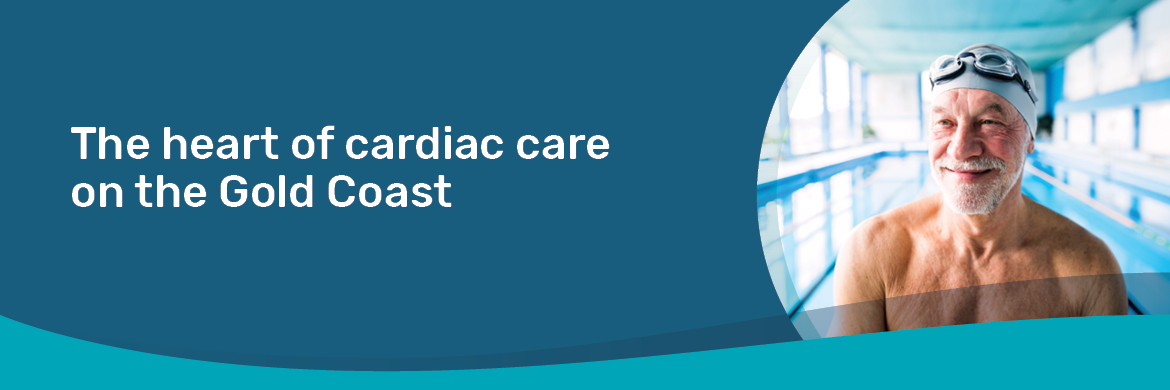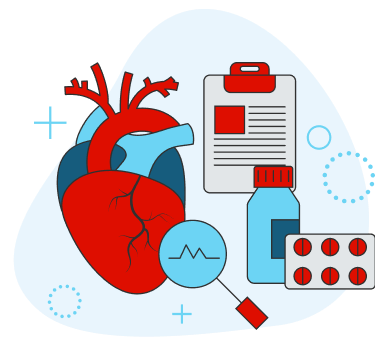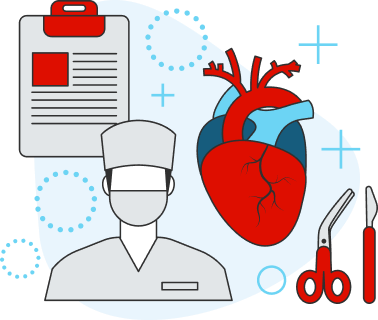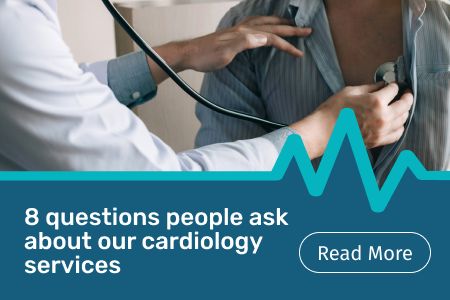
Cardiac Services
We perform the most comprehensive cardiac procedures of any private hospital on the Gold Coast thanks to our growing team of cardiologists and cardiothoracic surgeons who work as a team to care for our patients. It’s not just the number and complexity of surgeries that make us the heart of cardiac health care - the equipment and technology are world class.
We provide integrated cardiology care incorporating diagnostic, therapeutic and procedural services in our leading edge catheter labs and hybrid theatre suites. All our cardiac services are supported by our coronary care unit and 14 bed intensive care unit.
Find a cardiac specialist or doctor

Our world class cardiologists and cardiothoracic surgeons treat a range of heart conditions and related symptoms.
If you are experiencing any of the symptoms listed below:
1. Chest pain/Angina
2. Palpitations- racing or irregular heartbeat.
3. Shortness of Breath
4. Dizziness or fainting
5. Signs of heart failure – swollen ankles, unable to lie flat or waking short of breath
6. Heart murmur
You should contact your GP or present to our emergency department for assessment.
If you require urgent attention dial 000 (triple zero) and ask for an Ambulance.
Heart disease remains the main cause of death in Australia. Gold Coast Private Hospital is the leading cardiac hospital on the Gold Coast, where the state’s most sought after cardiac providers fight this statistic by dedicating themselves to the best possible care.
It's safe to say that you, the patient, are at the heart of everything we do.
The private experience
Expect better when you’re with us. Situated in the new health precinct on the northern end of the Gold Coast, most patients enjoy the privacy of a single room. And you’ll love the Private Dining menu, created by our Executive Chef, where you’ll enjoy nutritious, delicious meals. You truly are our focus.
Next steps
If your GP has recommended more complex cardiac care, ask for a referral to one of the state’s leading specialists. Tell them that you prefer to be treated at Gold Coast Private Hospital, the heart of cardiac care on the Gold Coast.
Procedures we offer
Coronary Artery Bypass Grafting (CABG)
Coronary bypass surgery, otherwise known as coronary artery bypass graft (CABG) surgery is a procedure that uses another artery or vein to restore blood flow to your heart muscle by bypassing the area of blockage or narrowing.
Aortic, Mitral & Tricuspid Valve Surgery
For severely narrowed or leaking valves these may be repaired or replaced. This can be achieved with standard surgery, less invasive surgery or via minimally invasive catheter-based procedures. To replace a heart valve, your doctor may remove the heart valve and replace it with a mechanical valve or a biological tissue valve.
Ablation for Atrial Fibrilations
Cardiac ablation uses heat (radiofrequency) energy to create tiny scars in your heart to block abnormal electrical signals that cause rhythm disturbances. This procedure is used to correct heart rhythm problems such as atrial fibrillation supraventricular tachycardia.
Minimally Invasive Valve Surgery
Minimally invasive cardiac surgery can be performed for certain cardiac surgery This involves having small incisions on the side of the chest rather than through the sternum and the use of small cameras to assist the operator. This can result in less pain post procedure and faster recovery
Transcatheter Aortic Valve Implantation (TAVI) (less invasive aortic valve replacement)
Transcatheter aortic valve implantation (TAVI) is a minimally invasive heart procedure performed via femoral artery access and avoids the need for a large surgical cut. Your Cardiologist and surgeon will advise if this procedure is suitable for you.
MitraClips (TMVR)
Transcatheter mitral valve surgery can be performed minimally invasively repairing a leaking valve with a clip called MitraClip. A mitraclip is inserted into your heart via the vein of your leg. The clip is applied to the leaflets of the Mitral valve to assist with better closing of the leaflets and decrease back blood flow
PFO (Patent Foramen Ovale) and ASD (Atrial Septal Defect) Closures
PFO is a flap like hole between the left and right atriums in the heart that is required when in the womb and normally closes after birth. In some cases, this does not close allowing blood clots to flow in the wrong direction and potentially causing a stroke, heart attack and migraines. ASD is similar to PFO but is a structurally abnormal congenital defect. These generally can be closed with a minimally invasive procedure.
Left Atrial Appendage (LAA) Closure
The left atrial appendage is a small pouch located in your left atrium. Closure of this pouch can be done with a minimally invasive procedure to prevent blood clots from forming in this pouch if you suffer from atrial fibrillation and cannot tolerate blood thinners.
Coronary Angiograms
Coronary angiography is the process of taking images of the coronary “heart” arteries by passing a thin tube called a catheter through an arm or leg artery to the top of the heart. A small amount of contrast is injected and an x-ray camera outside the body takes images.
Coronary angioplasty and stenting are procedures to reopen blocked or significantly narrowed coronary arteries. This will involve inflating a balloon and a stent (an expandable metal scaffold) into the artery to restore blood flow.
Angiography and stenting are commonly performed under local anaesthetic and IV sedation without the need for a general anaesthetic.
DC Cardioversion (DCCV)
DC cardioversion (DCCV) is used to treat irregular heart rhythms - commonly atrial fibrillation. The procedure involves a general anaesthetic and placement of electrodes on the chest. An electrical impulse or shock is delivered to return the heart rhythm to normal.
Transesophageal Echocardiogram (TOE)
A transesophageal echocardiogram is a type of echocardiogram (heart ultrasound) that takes images from behind the heart. This is achieved by passing the probe down the back of the throat (very similar to an endoscopy or gastroscopy procedure). The images obtained are of better quality than a normal echocardiogram due to the lack of lung (air) between echo probe and heart.
Fractional Flow Reserve (FFR)
FFR (Fractional flow reserve) is a technique used in coronary catheterization to measure pressure differences across a coronary artery stenosis (narrowing, usually due to atherosclerosis) to determine the likelihood that the stenosis impedes oxygen delivery to the heart muscle (myocardial ischemia).
- Rapidly assess the hemodynamic significance of individual coronary artery lesions.
- Easily performed in Cath Lab.
- Effectively guides coronary revascularization procedures leading to improved patient outcomes.
- Used to determine whether or not coronary lesions that are visualized angiographically should undergo percutaneous intervention.
Instantaneous Wave-Free Ratio (IFR)
IFR is a Diagnostic tool used to assess whether a stenosis is causing a limitation of blood flow in coronary arteries with subsequent ischemia.
Intravascular Ultrasound (IVUS)
Angiography gives a general look at the coronary arteries, but does not show the walls of the arteries.
IVUS (Intravascular Ultrasound) images show the artery walls and can reveal cholesterol and fat deposits (plaques). Buildup of these deposits can increase your risk for a heart attack used to assist the cardiologist to ensure the stent is correct size and well opposed to the artery wall.
Optical Coherence Tomography (OCT)
OCT (Optical Coherence Tomography) uses a catheter that uses infrared light to map the structures of a cardiac vessel. The result is a detailed tissue image with extraordinarily high resolution used to assist the cardiologist to ensure the stent is correct size and well opposed to the artery wall.
Intra Cardiac Echo (ICE)
ICE is an imaging tool that provides cardiac echo from the tip of a Cather used to assist with visualisation of cardiac structures
Rotablation Device (artherectomy device)
IS a device used to sand and debulk excess calcium that has built up in the coronary artery to allow space for a stent to be inserted?
CT of Coronary Arteries (CTCA)
CTCA uses computed tomography (CT) scanning to take detailed images of the heart. It is a quick (scanning takes 15 seconds) and easy test, without the need for invasive procedures, to determine if there are any significant narrowing in the heart arteries.
Diagnostic Electrophysiology Study (EPS)
Electrophysiology studies, (EPS) are a series of tests that examine your heart's electrical activity. They involve mapping the electrical paths in the heart to determine if significant electrical abnormalities exist. This may be carried out prior to considering the best management for heart arrhythmias.
Ablation (including 3D mapping)
Is a procedure that creates little scars in the heart to prevent inappropriate electrical signals that cause arrhythmias
All Pacemakers Including AICD and Leadless Pacemakers
A pacemaker is a small device usually inserted under the skin of the upper chest and attached to a pacing wires that stimulate your heart when your heart is unable to do so adequately. This procedure is commonly performed under local anaesthetic without the need for a general anaesthetic.
Implantable Loop Recorder
An implantable loop recorder is a convenient and easy way to obtain long term ECG recording by implanting a tiny paperclip sized device under the skin. This device can record ECGs for 3 plus years and is generally suited for patients with unexplained fainting and strokes/mini strokes of unknown cause. Your doctor can remotely monitor your heart rhythm via a mobile link that you keep in your home.
Cardiac Rehabilitation Program
Once treated, our outpatient cardiac rehabilitation program is designed to bridge the gap between hospital and the return to an active lifestyle. It includes a five week program comprising education and exercise twice a week.
This program is designed for people who have had cardiac surgery or suffered a heart attack.
Our rehabilitation referral form is quick and easy to use and designed for specialists, GPs and hospitals. Please provide the relevant details including patient particulars, medical background and health fund information.
![]()
Submit your referral via fax (07) 5530 0650 or email gcprehab@healthscope.com.au, our friendly team will take care of the rest.





